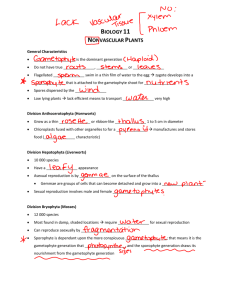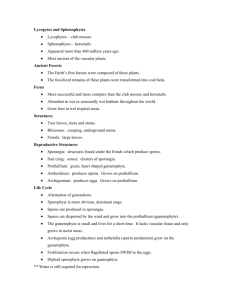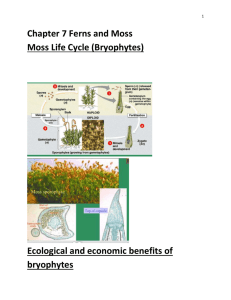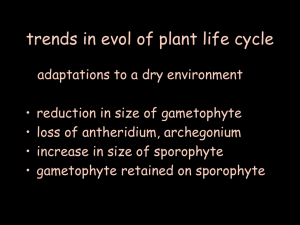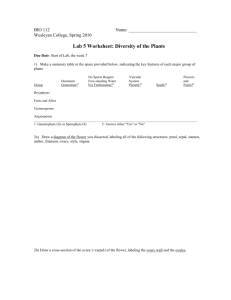Sexual Life cycles Plant structure and Phylogeny
advertisement
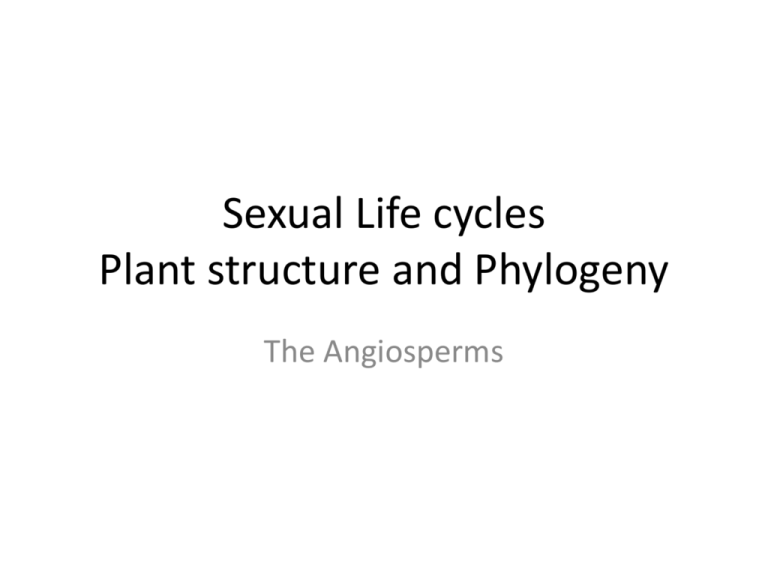
Sexual Life cycles Plant structure and Phylogeny The Angiosperms Outline • • • • Brief review 9. ALTERNATION OF GENERATIONS 8. PLANT EVOLUTION 7. ANGIOSPERM LIFE HIST. Define sex cell. All life is organized into 3 domains • 2 Domains of prokaryotes, 1 of all eukaryotes • Bacteria & Archaeaprokaryotic • Eukaryota- Includes all 4 eukaryotic kingdoms: protista, animalia, plantae, fungi Most of the many Eukaryotic species reproduce sexually Despite an inherent twofold cost, higher species reproduce sexually • Sexually reproducing species must have 2 offspring to “break even” • 2 offspring from an asexually reproducing species doubles the population Animal species alternate between diploid (mitotic) and haploid (meiotic) In animals, only the diploid stage is multicellular Sexual life cycle of Animals gametic or diplontic - meiosis forms gametes, no spores - mainly like a sporophyte (2n) - produce gametes (1n) via meiosis - fertilization results in zygote (2n) - sporophyte grows via mitosis Schematic gametic life cycle Sporophyte Many fungi work the opposite way zygotic or haplontic - zygote undergoes meiosis - mainly like a gametophyte (1n) - produce gametes (1n) via mitosis - fertiliz. results in zygote (2n) - produce spores (1n) via meiosis - gametophyte grows via mitosis Most plants have two multicellular life cycle stages- gametophyte and sporophyte plants - sporic or diplohaplontic - alternate sporo- & gametophyte - meiosis forms spores - sporophytes (2n) dominate - produce spores (1n) via meiosis - gametophyte (1n) develops inside cone/flower via mitosis - prod. gametes (1n) via mitosis - fertiliz. results in zygote (2n) - sporophyte grows via mitosis 8. PLANT EVOLUTION Plant phylogeny The Phylum Bryophyta includes liverworts and mosses Simplest terrestrial plantsavascular evolve multicell. & terrestrial - adapt to gravity, so small/low - no roots, rhizoids only anchor - sperm needs H2O to fertilize ova In mosses, the sporophyte and gametophyte are similar in size Ferns are vascular plants ferns (Phylum Pterophyta) evolve vasculature (vessels), allows fronds to grow large - true roots absorb H2O, minerals - no seeds, sperm still needs H2O The gametophyte is smaller in the fern life cycle The gametophyte nurtures the young sporophyte Conifers are the prototypical gymnosperm gymnosperms (Phy. Coniferophyta) - evergreen needles reduce evap. • ova in larger female cones • sperm in pollen grains from male cones, dispersed by wind • no fruit, naked seeds protect + provide nutrients to embryo Gymnosperms include cycads & ginkoes Gymnosperms have no flowers or fruits • Mostly windpollinated • The most massive indiviual living things- Giant sequoia The tallest and most massive- here in CA Male & Female Gametophytes are greatly reduced in gymnosperms Angiosperms are flowering plants angiosperms (Phylum Anthophyta) - deciduous leaves drop off in winter, surv. low temp/H2O • flowers attract animal pollinators with color-smell-nectar, • more efficient for fertilization • endosperm in seeds stores nutrients, esp. in grains/nuts • fruit attracts animals to disperse & fertilize seeds, reduces comp. Basic (monoecious) Flower structure The male angiosperm gametophyte is even smaller inside anthers - meiosis prod. microspore (1n) - becomes the pollen grain = male gametophyte (1n) - with 2 sperm cells + tube cell The female gametophyte houses the seed • inside carpels - meiosis prod. megaspore (1n) becomes the ovary = female gametophyte (1n) • = ovum + central cell (n+n) Pollination • pollination - pollen grain to stigma - tube cell grows pollen tube to reach ovary • double fertilization • - 1st sperm cell (1n) + ovum (1n) • = zygote (2n sporophyte) The seed is a capsule containing a plant embryo • - 2nd sperm cell + central cell (n+n) = endosperm (3n, food in seed) • seed - seed coat around endosperm - zygote grows into embryo via mitosis - ovary around seed becomes fruit The plant embryo is already formed • embryo - epicotyl becomes shoot • - hypocotyl becomes root • - cotyledons becomes leaves Plant phylogeny 6. MONOCOTS VS. DICOTS • • • • • • • • • • • • • • angiosperms - flowering plants - divided into 2 major groups monocots - corn, grasses - 1 cotyledon (embryonic leaf) - narrow leaves with parallel veins - flower parts in 3’s, fibrous roots - vascular bundles scattered, primary growth only dicots - most other angiosperms - 2 cotyledons absorb endosperm - broad leaves with network veins - flower parts in 4 or 5’s, taproot - vasc. bundles arranged in ring, secondary growth possible Monocots vs. Dicots


